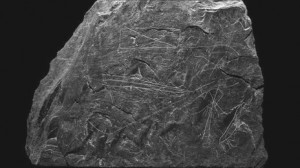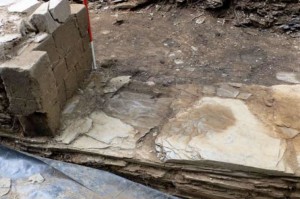 A team of archaeologists on their fourth year of excavations at the 12th century Nevern Castle in Pembrokeshire, Wales, have unearthed 12 slates inscribed with a variety of designs. Found at the south entrance to the castle, the scratched symbols were probably made by laborers to keep evil spirits from crossing its threshold.
A team of archaeologists on their fourth year of excavations at the 12th century Nevern Castle in Pembrokeshire, Wales, have unearthed 12 slates inscribed with a variety of designs. Found at the south entrance to the castle, the scratched symbols were probably made by laborers to keep evil spirits from crossing its threshold.
Inscribed slates from this early on are a rare discovery. There’s a later Welsh tradition of scratching curses or blessings on slate tiles and throwing them down wells, but what you usually see are the initials of a cursee or blessee inscribed, not symbols.
“Scratched images from the medieval world are rare, and we can confidently date these to the period 1170-1190 when the stone phase of Nevern Castle was built,” added [Lead archaeologist Dr. Chris] Caple.
“These drawings connect us with the lives and beliefs of masons or labourers who built the castle. We hardly ever recover evidence about the peasants of the medieval world, and never information about their beliefs and ideas, but these scratched designs are from the imagination of a serf, a farm labourer or a man at arms.”
Welsh slate had been quarried and used as a building material, particularly roof tiles, since the Roman period. The south entrance was made of slate bedded with clay, a local building technique that creates a strong structure as long as you ensure the bedded slate walls are capped with large stones or wide eaves to ensure rain doesn’t wash the clay away.
 On top of the clay bedded slate, the doorway was built out of blocks of local sandstone. Finely chiseled, evenly faced square blocks of sandstone were not a local building technique at this point. That style was imported by the Anglo-Norman invaders, and in fact it was Anglo-Norman lord Robert FitzMartin who built Nevern castle as we know it today in the first decade of the 12th century. That makes the doorway an extremely early fusion of native and invader construction.
On top of the clay bedded slate, the doorway was built out of blocks of local sandstone. Finely chiseled, evenly faced square blocks of sandstone were not a local building technique at this point. That style was imported by the Anglo-Norman invaders, and in fact it was Anglo-Norman lord Robert FitzMartin who built Nevern castle as we know it today in the first decade of the 12th century. That makes the doorway an extremely early fusion of native and invader construction.
Control of the castle shifted over the century between FitzMartin and Welsh prince Rhys ap Gruffudd. During the period in which those slates were inscribed, 1170-1190, the castle was in FitzMartin’s hands. Most of the masonry was built onto the timber and earthenworks castle by The Lord Rhys between 1135 and 1170, but FitzMartin is thought to have added some new stone structures after he regained control. By 1195 it was back in Welsh hands, but Rhys died in 1197 and his son Hywel Sais demolished much of it and left it to decay.
Its short lifespan and connection to Rhys ap Gruffudd makes the castle an important site for Welsh history. Not only was Rhys a powerful figure in his time, but if archaeologists can pinpoint buildings that he added on to the castle, that will make Nevern the earliest excavated remains of a stone castle built by the Welsh themselves.
I remember reading about a supposed tradition where a body was buried under the doorway like that. Not sure if it is true or who was supposed to have practiced it.